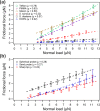Characterization of the microscopic tribological properties of sandfish (Scincus scincus) scales by atomic force microscopy
- PMID: 30416912
- PMCID: PMC6204795
- DOI: 10.3762/bjnano.9.243
Characterization of the microscopic tribological properties of sandfish (Scincus scincus) scales by atomic force microscopy
Abstract
Lizards of the genus Scincus are widely known under the common name sandfish due to their ability to swim in loose, aeolian sand. Some studies report that this fascinating property of sandfish is accompanied by unique tribological properties of their skin such as ultra-low adhesion, friction and wear. The majority of these reports, however, is based on experiments conducted with a non-standard granular tribometer. Here, we characterise microscopic adhesion, friction and wear of single sandfish scales by atomic force microscopy. The analysis of frictional properties with different types of probes (sharp silicon tips, spherical glass tips and sand debris) demonstrates that the tribological properties of sandfish scales on the microscale are not exceptional if compared to snake scales or technical surfaces such as aluminium, Teflon, or highly oriented pyrolytic graphite.
Keywords: Scincus scincus; biotribology; frictional properties of reptile scales; sandfish.
Figures








Similar articles
-
Neutral glycans from sandfish skin can reduce friction of polymers.J R Soc Interface. 2016 Mar;13(116):20160103. doi: 10.1098/rsif.2016.0103. J R Soc Interface. 2016. PMID: 27030038 Free PMC article.
-
Environmental interaction influences muscle activation strategy during sand-swimming in the sandfish lizard Scincus scincus.J Exp Biol. 2013 Jan 15;216(Pt 2):260-74. doi: 10.1242/jeb.070482. J Exp Biol. 2013. PMID: 23255193
-
Adaptation to life in aeolian sand: how the sandfish lizard, Scincus scincus, prevents sand particles from entering its lungs.J Exp Biol. 2016 Nov 15;219(Pt 22):3597-3604. doi: 10.1242/jeb.138107. J Exp Biol. 2016. PMID: 27852763 Free PMC article.
-
Investigating the locomotion of the sandfish in desert sand using NMR-imaging.PLoS One. 2008 Oct 1;3(10):e3309. doi: 10.1371/journal.pone.0003309. PLoS One. 2008. PMID: 18836551 Free PMC article.
-
Diatom bionanotribology--biological surfaces in relative motion: their design, friction, adhesion, lubrication and wear.J Nanosci Nanotechnol. 2005 Jan;5(1):79-87. doi: 10.1166/jnn.2005.018. J Nanosci Nanotechnol. 2005. PMID: 15762164 Review.
Cited by
-
Simulation and Structural Analysis of a Flexible Coupling Bionic Desorption Mechanism Based on the Engineering Discrete Element Method.Biomimetics (Basel). 2024 Apr 8;9(4):224. doi: 10.3390/biomimetics9040224. Biomimetics (Basel). 2024. PMID: 38667235 Free PMC article.
-
Morphological study of the integument and corporal skeletal muscles of two psammophilous members of Scincidae (Scincus scincus and Eumeces schneideri).J Morphol. 2021 Feb;282(2):230-246. doi: 10.1002/jmor.21298. Epub 2020 Nov 9. J Morphol. 2021. PMID: 33165963 Free PMC article.
References
-
- Arnold E N. J Zool. 1995;235:351–388. doi: 10.1111/j.1469-7998.1995.tb01758.x. - DOI
-
-
Rechenberg, I. Tribologie im Dünensand: Sandfisch, Sandboa und Sandschleiche als Vorbild für die Reibungs- und Verschleißminderung; TU Berlin, Germany, 2009. doi:10.2314/GBV:732558328
-
LinkOut - more resources
Full Text Sources
Molecular Biology Databases
